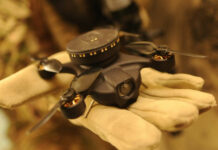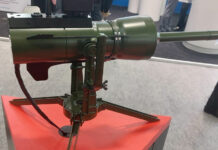Soldier’s survivability is improved with superior bullet-proof ballistic protection, enhancement of mobility and introduction of advanced firepower that can be employed at extended standoff range, thus eliminating the mandatory phase of close quarters fight in every combat engagement. Modern, light weight body armor, helmets and eyewear are currently available, offering more effective protection against multiple hits from small arms and shrapnel.
Helmets constructed from advanced bullet proof composite materials have become much lighter and offer improved protection and comfort. Advanced features include integrated headgear such as osteo-phone acoustics, helmet mounted displays and vision systems. As head mounted gear becomes lighter, more instruments are placed on the helmet, offering unrestricted hemispherical view for visual sensors, GPS receivers and RF (radio) communications. However, helmet mounted electronics require power, which ads significant weight to the headgear. Use of system miniaturization, power management and wireless networking (Bluetooth) enable designers to optimally distribute weight on the helmet and upper body adding to the wearer’s personal comfort.
The latest versions of body armor gear are designed as flexible, mission adaptable suit. The modern anatomic vests are relatively lightweight, made of composite, bullet proof materials such as the Kevlar body armor, providing basic protection from shrapnel and low-speed small-arms threats, to the upper body. The protection level is further increased by add-on panels, utilizing harder and heavier ceramic inserts emplaced into specially designed pocket placed around the torso, groin and shoulders. These inserts provide higher levels of protection, as required by the expected threat level. (7.62AP, 9mm etc). Apart from protection, ergonomics present significant factors in bulletproof vest design. The bullet-proof vest adds substantial weight to the soldier’s load. Ballistic shields and bullet proof vests are common add-on elements to infantry suits; however, they are not yet integrated with load bearing vests (combat webbing) due to ergonomic, logistical and cost considerations. While such integration is technologically feasible and could save some weight, it turns the load bearing vest from a relatively simple lightweight textile product into a composite-made protection system with a proportional price tag.
A vital element in the soldier’s survivability is camouflage. Uniform design patterns are currently designed to merge with various environments. Offered in basic families of European, Arctic (snow), desert and urban designs, camouflage patterns enable effective blending with surrounding environments. Camouflage suits are also provided for snipers and special-forces requiring higher performance. As operations are shifting to night time, patterns must match requirements for night combat maintaining effective camouflage in darkness, under visibility by Imaging Infrared or thermal equipment. Signature reduction is also considered essential for concealment of body heat, as it is viewed by thermal sensors and sights.
Due to technological limitations, dedicated protection suits are developed and used for specific operational conditions. For example, add-on Chemical Bacteriological Radiological (CBR) protection is worn when such threats are imminent. These suits considerably limit the soldier’s mobility and comfort and are only used for relatively short periods.
Additional parts of this article:
- Infantry Combat Suits
- Infantry Combat Suits – Firepower
- Infantry Combat Suits – Survivability & Protection
- Infantry Combat Suits – Mobility & Ergonomics
- Infantry Combat Suits – Computers & Communications
- Future Force Warrior Uniform, Protection and Combat Gear
- Future Force Warrior Communication and Computation
- Future Force Warrior Infantry System of Systems (SOS)
- Felin Infantry Combat Suite



















